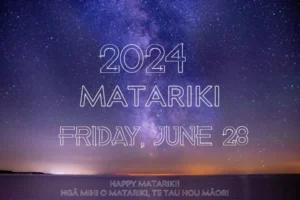The Connection Between Matariki and Māori Mythology
The Māori people of New Zealand have a rich mythology, and the story of Matariki is an important part of that mythology. Matariki, the Māori New Year, is celebrated when the Matariki cluster of stars (also known as Pleiades) appears in the sky during late May or early June. The appearance of Matariki signaled a time of reflection and celebration in Māori culture. In this blog post, we will explore the connection between Matariki and Māori mythology in more detail.
Creation Mythology and Matariki In Māori mythology
Creation Mythology and Matariki In Māori mythology, the creation story tells of the god Ranginui (Sky Father) and Papatuanuku (Earth Mother) who were once locked in a tight embrace, preventing their children from seeing the light of day. The god Tane separated his parents, allowing light to enter and enabling life to flourish. Tane is also credited with creating the stars, including the Matariki cluster, which are said to represent the eyes of Tawhirimatea, the god of the winds and storms.
The Story of Matariki
The story of Matariki is told differently in various parts of New Zealand, but the common theme is that Matariki was a time of new beginnings and a time to remember those who had passed. One of the most well-known versions of the story involves the god Ranginui and his wife Papatuanuku. When their children, who were gods and goddesses, tried to separate them, the sky and the earth became separated, leaving Ranginui to dwell in the sky and Papatuanuku on the earth. When Matariki appeared in the sky, it signaled to the people that Ranginui was weeping for his separation from his wife, and that it was a time to reflect on the past and plan for the future.
Another version of the story tells of the goddess Matariki, who is said to have been the mother of the other six stars in the Matariki cluster. Matariki was associated with fertility, and the appearance of the stars signaled the time to plant crops and begin preparations for the coming year.
Significance of Matariki in Māori Culture Matariki
Significance of Matariki in Māori Culture Matariki has deep cultural significance for the Māori people of New Zealand. It is a time to acknowledge the past, celebrate the present, and plan for the future. It is a time to honor those who have passed and to give thanks for the abundance of the land. In modern times, the celebration of Matariki has been revived and has become an important part of New Zealand’s cultural identity. It is celebrated in many ways, including through cultural events, feasts, and storytelling.
The Seven Stars of Matariki and their Significance The Matariki cluster is made up of seven stars, each with its own significance in Māori culture. The seven stars and their meanings are as follows:
- Matariki – The mother of the other six stars and the star that marks the beginning of the Māori New Year.
- Pōhutukawa – Represents memories of those who have passed and the connection between the living and the dead.
- Waitī – Represents fresh water and the life-giving properties it provides.
- Waitā – Represents the ocean and its role in sustaining life.
- Tupuānuku – Represents food grown in the soil, such as kumara (sweet potato) and other crops.
- Tupuārangi – Represents food grown in the sky, such as birds and fruits.
- Ururangi – Represents the winds and the importance of navigation and travel.
Celebration of Matariki
celebration of Matariki has evolved over time and is now a significant event in modern New Zealand. It is celebrated by people of all cultures and backgrounds, and has become an important time for reflection, gratitude and renewal.
One of the ways Matariki is celebrated in modern times is through community events and festivals. Many towns and cities hold Matariki festivals, which include cultural performances, food, music, and art. These festivals provide an opportunity for people to learn about Māori culture and to participate in traditional Māori activities.
Educational Programs
Another way Matariki is celebrated is through educational programs. Many schools and universities now incorporate Matariki into their curriculum, teaching students about Māori culture and the significance of the Matariki season. This helps to promote a deeper understanding and appreciation of Māori culture among young people.
In recent years, Matariki has also become an important time for environmental awareness and sustainability. The season coincides with the winter solstice, which is the shortest day and longest night of the year. This time of darkness and stillness is seen as an opportunity to reflect on our relationship with the natural world and to make positive changes to protect the environment.
As well as community events and educational programs, many individuals and families celebrate Matariki in their own way. This can include gathering with loved ones to share a meal, performing traditional Māori activities such as weaving and carving, or simply taking time to reflect and set intentions for the coming year.
In conclusion, the celebration of Matariki is an important part of New Zealand’s cultural identity and has deep roots in Māori mythology and culture. It is a time to reflect on the past, acknowledge achievements, and plan for the future. Whether celebrated through community events, educational programs, or personal traditions, Matariki provides an opportunity for people to connect with each other, with nature, and with the rich cultural heritage of New Zealand.


